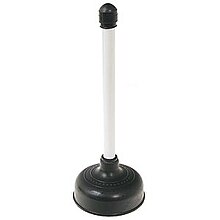They are making a few great annotation relating to How to Unclog Your Sink with a Plunger in general in this article just below.

Introduction
Appropriate upkeep of family drains pipes is crucial for protecting against blockages and guaranteeing smooth water flow. Among the secret tools in every home owner's toolkit is the bettor, alongside numerous drainpipe cleansers developed to tackle stubborn clogs efficiently. This short article explores just how to use bettors and drain cleansers effectively to maintain your drains streaming openly.
Section 1: Recognizing Plungers
Kinds of Plungers
There are numerous types of plungers readily available, each designed for different kinds of drains pipes and clogs. The most typical kinds consist of mug bettors, flange bettors, and accordion plungers.
Exactly How Plungers Job
Bettors deal with the principle of producing stress and suction to displace clogs. When correctly applied over a drain, they produce a vacuum cleaner that can take out particles or separate obstructions.
Picking the Right Bettor
Picking the ideal bettor depends upon the kind of drain and the nature of the blockage. Cup plungers are ideal for sinks and bathtubs, while flange bettors are much better fit for toilets due to their layout.
Usual Errors with Plungers
Staying clear of these errors guarantees effective plunging: inappropriate seal around the drainpipe, insufficient pressure, and unclear surrounding particles.
Section 2: Making Use Of Plungers Successfully
Preparation
Prior to plunging, make sure the plunger covers the drainpipe completely and develops a limited seal. Clear any type of noticeable debris around the drainpipe opening.
Strategy
Start with mild diving motions to develop suction. Rise pressure slowly, making use of a steady rhythm. Repeat as needed till the drain clears.
Fixing Tips
If diving does not function, attempt readjusting the seal, applying petroleum jelly for a far better seal, or making use of a different type of plunger.
Section 3: Recognizing Drainpipe Cleaning Company
Types of Drain Cleaners
Drain cleaners can be chemical or enzymatic. Chemical cleaners utilize strong chemicals to dissolve blockages, while enzymatic cleaners make use of natural enzymes to break down raw material.
Exactly How Drainpipe Cleaners Job
Chemical cleansers react with obstructions to dissolve them, while chemical cleansers break down organic materials like hair and grease without hurting pipelines.
Security Considerations
Constantly use handwear covers and eye security when utilizing chemical drain cleansers. Guarantee ample air flow and follow maker instructions very carefully.
Eco-Friendly Alternatives
Take into consideration using vinegar and baking soft drink or enzyme-based cleansers for environment-friendly alternatives that are much safer for pipelines and the setting.
Area 4: Using Drain Cleaners Successfully
Application Methods
Put chemical cleaners directly into the drain opening. Allow them to work for the recommended time prior to purging with warm water. Enzymatic cleaners should rest over night.
Safety measures
Prevent mixing different sorts of cleaners, as this can generate toxic fumes. Never utilize chemical cleaners in conjunction with a bettor, as spilling can happen.
Dealing With Persistent Blockages
For persistent obstructions, think about using a pipes snake or calling a specialist plumbing professional to prevent damages to pipelines.
Conclusion
To conclude, recognizing how to utilize bettors and drainpipe cleaners efficiently is essential for maintaining healthy plumbing systems. By choosing the right devices and methods, home owners can take on minor blockages and protect against significant pipes concerns down the line.
4 DIY Ways to Unclog Drains
Wire Hanger
This age-old technique has been used by many an amateur plumber – to much success. Take any wire hanger, deconstruct its shape and leave a small hook shape on the end. Time to go fishing! Remove the shower or sink drain cover and snake the wire into the drain, wiggling and rotating it as you push it through. Dispose of the gunk that you remove and flush the drain with hot water. Rinse with a pan of boiling water for best results.
Plunger
Creating a suction in your drain can break up clogs caused by hair and soap residue build up. First, make sure you are using the correct type of plunger, one specifically for sinks or tubs. They are typically smaller than regular toilet plungers and often have a shallow suction cup. Regular plungers can work too but we’d recommend cleaning them first and finding a way to create better suction over the drain.
Baking Soda and Vinegar
This technique is a classic – and one of the most popular DIY drain unclog methods. Pour one cup of baking soda and one cup of vinegar down the drain and allow it to work its magic overnight. The next morning, flush the drain with boiling water. Repeat if necessary.
Drain Snake/Hair Clog Tool
If you know your clog is caused primary by hair, a drain snake/hair clog tool might be your best option. These tools can be purchased for under $10 at any hardware store and work well so long as the clog isn’t too deep in the drain.
https://www.callcatons.com/blog/four-diy-ways-to-unclog-drains/
:max_bytes(150000):strip_icc()/types-of-plungers-2718737-01-dc834975f2c047619ad4c855d39d07d3.jpg)
I hope you enjoyed our excerpt on How To Use Your Toilet Plunger Correctly in 5 Easy Steps. Thanks for finding the time to browse our post. Do you know about anybody else who is fascinated with the subject? Do not hesitate to share it. Thanks a lot for going through it.
Request Free Estimate
Comments on “How to Employ Plungers and Drain Cleaner Successfully: Professional Advice”